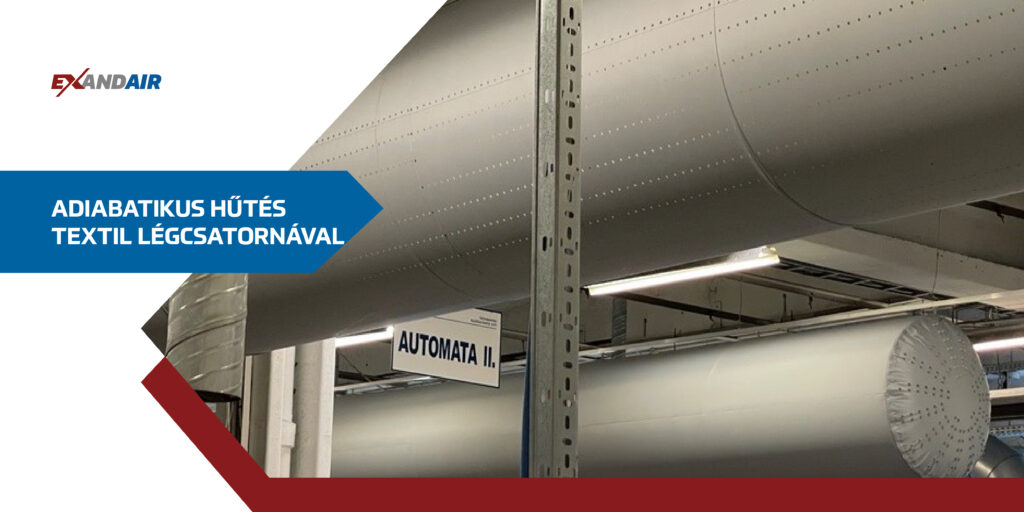Generally speaking, a spring factory is an industrial facility where high-quality springs can be produced using different heat treatment technologies. However, the production of springs consists of several steps. One of these steps is heat treatment, which involves high heat emissions and tests human tolerance.
One possible solution to air-condition the hall is an adiabatic cooling system with textile ducting, but planning and installing this in an older facility is by no means a routine task. In our latest case study, we show how we have found solutions to all the needs that arise.
.
The essence of the adiabatic cooling system
Application of the simplest law of physics. Let's introduce air into the hall, which is cooled by evaporating water. As a result, the warmer and drier the air outside - very typical in our country during the summer months - the more efficient the adiabatic cooling works.
The unit can have its own fan, so it can also serve to exchange air and recool the intake air by means of the normal tap water circulating in the unit. The unit may be mounted on the intake stub of an outdoor roof-mounted air handler to provide cooling.
In the summer months, 100% fresh air in the mornings in "free cooling" mode ensures the right internal temperature with almost no energy consumption. In such a case, when comparing the running costs (electricity, water consumption), they can be reduced by about 80 - 90% compared to the energy consumption of a liquid cooling system. This is a very significant saving. At the same time, the installation of the system is simpler, as there is no need to build an insulated pipe network thanks to the associated non-condensing, dimensionally draught-free and easy-to-clean textile air ducts.
.
EXANDAIR textile ducting performs well in the spring factory
When our dear customers approached us to help optimise the working conditions in the spring factory, we knew that an adiabatic cooling system with textile air ducts would be the solution.

.
When we contacted you, we were faced with the following situation:
The heat treatment furnaces in the spring factory emitted a considerable amount of heat, making the room unbearable in the summer because of the heat generated and the confinement of the room. However, the owner wanted to improve the working environment so that the investment would not be an extra burden on the company's budget.
The following needs have also been raised:
- Higher air speed system because of the heat (they wanted to feel the cooling air)
- A pleasant climate nonetheless
- Cost-effective implementation
.
But the solution was also complicated by a number of problems:
It was like this
- lack of space (the duct could not be installed in certain parts of the hall, as the system could only be installed low down, which would have obstructed traffic),
- the question of the load-bearing capacity of the roof (it was an old concrete slab, which could not be drilled very well and no one knew how much it could bear),
- you could only enter the building from the side, not from the roof,
- and also that the system could not be installed too close to the furnaces, lest it touch the hot air ducts and melt the textile air duct.
Moreover, the classic low air velocity comfort system is not satisfactory for a hot plant, so it was important to design and implement a solution with an optimal air velocity.
.
The EXANDAIR solution
After assessing the needs and looking at the problems, our engineers proposed the following solutions to improve the working environment:
- Installation of an adiabatic cooling system with textile ducting
- Construction of the backbone of the system close to the corridors
- Sideways perforation to allow air to flow sideways downwards to people working at the furnaces
- Prevent level jumps in the room with elbows and small pulls
- Installation of a lightweight track system on the ceiling (the textile duct itself is very light, weighing a tenth of the weight of conventional metal duct systems)
However, there was one other important condition: we couldn't interfere with traffic, so we couldn't run the system through every part of the room. So the question was, how do we effectively blow air where we can't reach?

Special end caps for adiabatic cooling systems
This question also made us think, as we were facing a new situation. Our engineers therefore designed a special air sealing cap for the textile duct system, i.e. they perforated the end seal so that the air can flow in a vortex-like manner in the space. This solution allows the air to be "shot" further, flushing the entire room with the right amount of air.
The adiabatic cooling system has improved the working conditions in the spring factory, as the air movement is better felt everywhere, and thanks to the textile air duct we have not burdened the roof, and the system is not too expensive to maintain.
Take a look at our case studies to learn more about the benefits of textile ducting systems, their many applications and contact us. Follow us on our Facebook page for instant updates.




